
Of course, technically Rome and The Vatican are separate entities, but for the visitor to "The Eternal City" they are one and the same. Rome's Via della Conciliazione leads directly to St. Peter's Basilica which is the only reason for the street's existence. Vatican city is a separate, and the smallest, European state.
Rising to a height of 448 feet, Michelangelo's dome is the visual centerpiece of the Vatican and of Rome. Michelangelo died before the dome was completed, but it had risen as far as the top of the drum by the time he died in 1564.
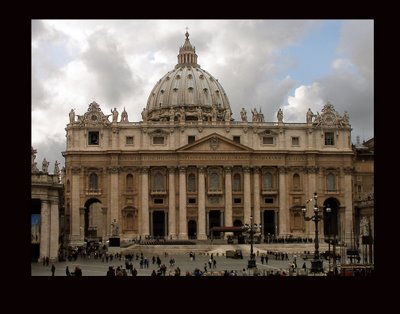
The scale of the Basicila is so far beyond what my eyes are accustomed to that I am always surprised as I step inside. I feel tiny approaching the giant doors, and I am dwarfed by the vast interior space. Not counting the 26-foot-thick walls, its 610 foot length makes it a couple of yards longer than London's St. Paul's. Located over the high altar way down front, Bernini's Baldacchino, the canopy built in 1633, is huge. The columns are 95-feet-tall, and there's plenty of room between them and the ceiling.
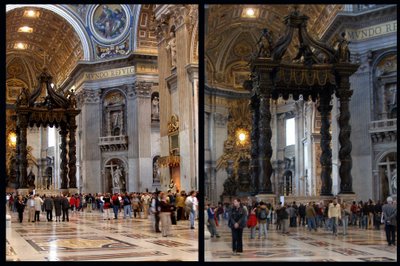
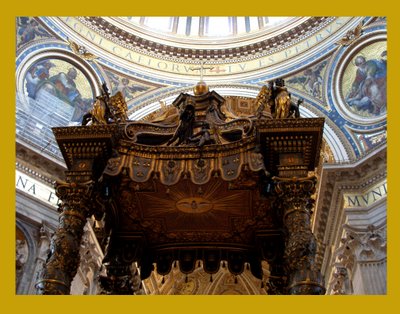
Margaret and I wanted to visit the Sistine Chapel. The Vatican Museum contains 4 1/2 miles of galleries. It seemed this time as if we walked at least a couple of miles to get to the Chapel. We had seen it first in 1971 long before Micaelangelo's ceiling was cleaned. We saw it again in the middle of the cleaning with the scaffolding still covering half of the ceiling. Now it's finished and seems almost too bright. Photography without flash is allowed in the rest of the museum, but not in the Sistine Chapel. It would have been impossible anyway. The room was very crowded and the light was low. It didn't matter. Being there was enough. Anyway, I got some ceiling photos in other parts of the Vatican Museum...just for the heck of it.. The ceiling of the Vatican Library wasn't done by Michelangelo, but it's spectacular, nonetheless.

In Rome the building that stuns me every time I see it, actually every time I think about it, is the Pantheon. Of the ancient buildings in Rome, it is the most perfectly preserved. Some people say it is the single most perfect building in the world. It was built by the Emperor Hadrian in AD 125 to be a temple for the various Roman gods (pantheon). It became the Roman Catholic Church of Santa Maria and Martyres in AD 609. The vast dome, unsupported by interior columns, was originally gilded with bronze both inside and out. I can imagine what it must have been like shining in the Roman sunlight. What is hard to imagine is that Pope Urban VIII and others could have dared take away the gilding from such a marvelous building. Urban VIII didn't hesitate to take bronze from the crossbeams of the Pantheon's portico and melt it down for the columns of the Baldacchino in the Basilica.

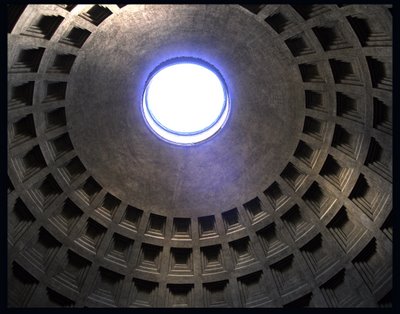
Castel Sant'Angelo (AD 139) is another round structure in Rome that commands attention. It was originally designed by Hadrian as his tomb. It was turned into a medieval fortress by the warrior popes. Composer Puccini set the climax of his opera "Tosca" there, and Dan Brown has it as an important setting for his novel "Angels and Demons." Pont Sant'Angelo crossing the Tiber in front of the castle is famous for its statues. It provides a dramatic approach to the Castle.
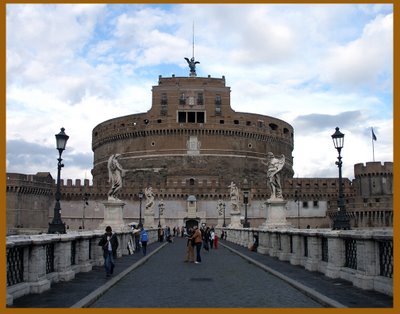
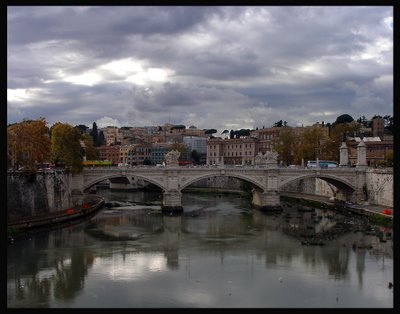
It's a short walk from the Pont Sant'Angelo through narrow Roman streets to Piazza Navona with its Bernini fountains. This piazza seems always to have something like a street fair going on in it. There is enough interesting history around this one place in Rome for an entire book. Several popes put their marks on the spot with lavish building projects, each trying to outdo his predecessor. Pope Innocent X added the Bernini Fountain of the Moor and the Fountain of the Four Rivers, both of which were covered with scaffolding in November. This third fountain was available for photographs.

The Trevi Fountain was installed in the 18th Century. The fountain is so big and imposing that you feel as if the horses are going to gallop right out of the water. The name for the fountain is a shortening of "tri vi" (three streets). Of course, Margaret and I tossed coins into the fountain to ensure that we would come back to Rome again.
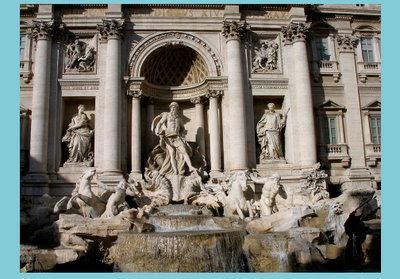
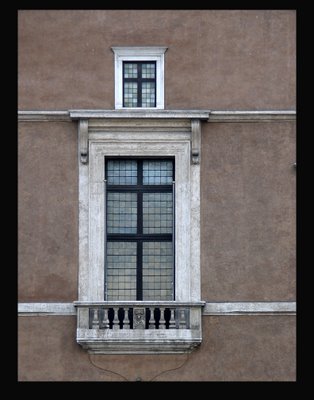 I didn't know until I started doing the background reading for this Blog posting that Mussolini was an even worse character than I had thought. In 1932 the dictator wanted to be able to see the Colosseum from his office balcony in the Palazzo Venezia, so he ordered the demolition of all medieval and Renaissance churches and palaces standing in the direct line from the Piazza Venezia to the Colosseum. When Il Duce's buddy Hitler came to Rome, they could review the Italian troops from temporary grandstands on this widened street. Fortunately, however, most of the Forum survived his megalomania. The photographs tell the story.
I didn't know until I started doing the background reading for this Blog posting that Mussolini was an even worse character than I had thought. In 1932 the dictator wanted to be able to see the Colosseum from his office balcony in the Palazzo Venezia, so he ordered the demolition of all medieval and Renaissance churches and palaces standing in the direct line from the Piazza Venezia to the Colosseum. When Il Duce's buddy Hitler came to Rome, they could review the Italian troops from temporary grandstands on this widened street. Fortunately, however, most of the Forum survived his megalomania. The photographs tell the story.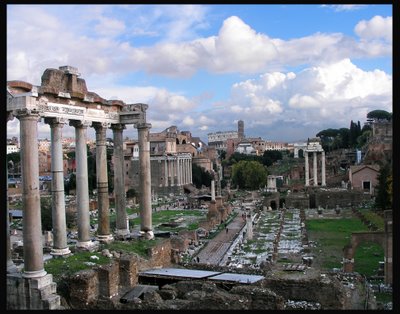

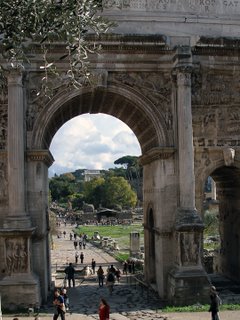
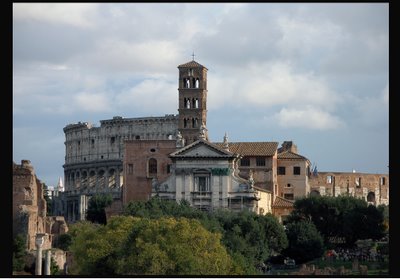
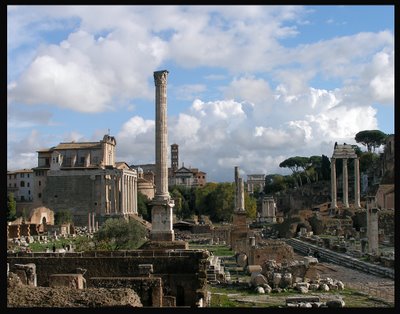
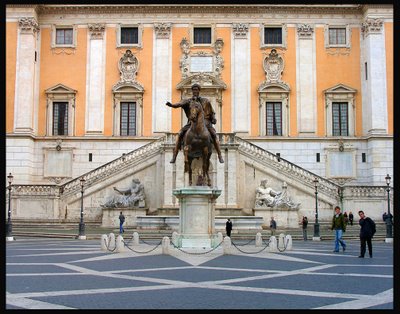
One of my favorite places in Rome is the Piazza del Campidoglio, the Capitoline. It was the site of the capital of the Western world during the Roman Empire. It was here that Brutus spoke of the death of Julius Caesar. It was also here that Petrarch was crowned with the laurel leaves.
The Piazza that we see today was designed by Michelangelo in 1538. It wasn't completed until 1648 for the triumphant entry into Rome of Charles V, the holy Roman emperor who had driven the moors out of Spain and back to North Africa. A statue of Marcus Aurelius stands at the top of Michelangelo's ramp. It dates from the 2nd Century and is the oldest equestrian bronze work to survive intact from antiquity.
To move from the sublime to the ridiculous, take a walk from Piazza del Campidoglio to the nearby Monument to Victor Emanuel II, called by foreigners "the wedding cake" or "the white typewriter." The monument was finished in 1911 as a monument to the unification of Italy in 1870 under the leadership of King Victor Emanuel II. After World War I the Tomb of the Unknown Soldier was added and is now guarded night and day by sentries. Most people agree that the big monument is out of harmony with its surroundings.
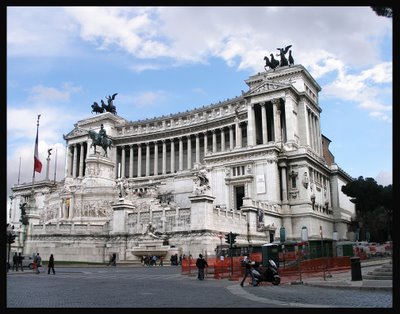
No comments:
Post a Comment